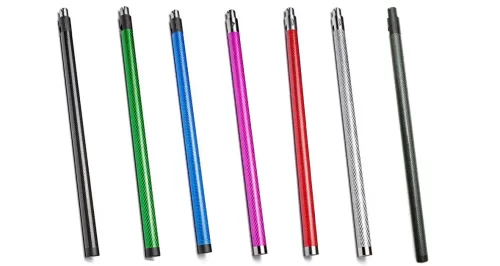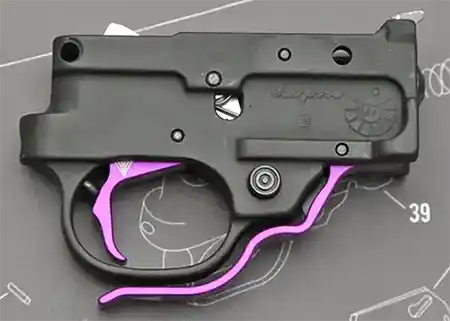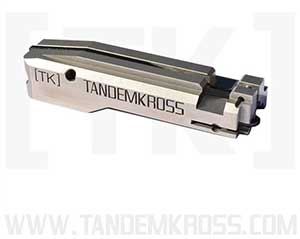This is part two of my upgrades for the Ruger 10/22 series. A little while ago, I wrote this article, on common 10/22 upgrades. Nearly every item listed was less than $20. This underscores one of the reasons that the 10/22 is so popular. Not only are there plenty of aftermarket options, but they are affordable. That said, the list was also mostly reliability items, and not so much performance. While it’s possible to enjoy a completely stock rifle (I’ve got one that hadn’t been modified in 32+ years) the itch to tinker sets in quickly. And the quest for even better reliability and accuracy is usually the goal, although we cannot deny aesthetics play a role too.
A bit About the Performance Upgrades for the Ruger 10/22 (and 22 Charger)
This article is mostly intended for folks that are new to the 10/22 rifle and 22 Charger platforms. If you’re competing with one, you probably know most of this already. For those that follow me on the forums and websites I frequent, you’ve seen me post that upgrades fall into three categories, but all work together. If you want better accuracy, upgrade your barrel. For more consistency, upgrade your trigger. And if you want more reliability, upgrade your bolt. Of course, all this requires a solid foundation, which is where the stock (or chassis) comes in. With that in mind, here are some suggestions on not just what to upgrade, but why.
Barrel Upgrades for the Ruger 10/22
Most 10/22s leave the factory with a perfectly adequate barrel. For plinking or small game hunting, they’re just fine. And although the right ammo plays a big role in accuracy, upgrading the barrel is generally required to get those little tiny groups.
Today, most barrels fall into two main groups. There are steel barrels, which are great off a bench, but not so great in the field. Then there are the sleeved barrels. These are generally a skinny steel barrel with an aluminum or carbon fiber sleeve. They cut weight, but offer a stiffer barrel, for better accuracy. Within these categories are sporter (tapered, thinner barrels) or bull (fatter, .920″ barrels) options. Both offer benefits, with few drawbacks. All are upgrades for the Ruger 10/22.

Purchase a barrel from any of the major aftermarket brands listed at the end of this article, and you’re not likely to be disappointed. Prices vary from around $130 for steel barrels, up to more than $300 for sleeved aluminum or carbon fiber. Before you choose any barrel, keep in mind that those sweet .920″ barrels do not fit in the factory stock. Unless you want to DIY sand the channel out, a stock upgrade is in order. So with your barrel budget, consider setting aside money for a new stock too.
While some barrel manufacturers have their own proprietary chamber, many do not. They use a Bentz chamber, which is tighter than a factory chamber, but looser than a match chamber. If you’re reading this, you’re not building a match rifle, so stick with that Bentz chamber. It will be less fussy about ammo, compared to a match chamber, but more accurate than the loose factory chamber that is designed to work with any and all ammo. The other thing most new owners ask about is barrel length. Anything between 16.5″ and 20″ is fine. There is no accuracy to be gained with a longer barrel. Threading is also nice, if you want to add a suppressor or muzzle device.
Trigger Upgrades for the Ruger 10/22
Ruger ships their 10/22s with a trigger that is safe for beginner shooters. It’s not too light, and not overly heavy. Upgrading to a lighter trigger will help greatly with accuracy, but only to a point. It’s just one part of the system. Of course, just being lighter doesn’t make a good trigger. It should have minimal pre-travel and over-travel. That is the amount the trigger moves before it “breaks”, as well as how far it goes after. It should also have a short reset. How this is all achieved depends on who is making the trigger. Improving your trigger can cost as little as $60, up to around $300.
For about $60 (probably more, these days), you might find a Ruger BX trigger. It’s a bit lighter than the factory one, but nothing special. Consider it an improvement, but just a small increment. Next step up is a mixed bag. Brimstone does excellent work, but that usually involves shipping them your trigger group, and waiting for it to come back. Although they will sell you one, and then modify it before sending it to you.

Next are the drop-ins, which you can do yourself. TandemKross offers a kit in collaboration with Brimstone. It’s about $135, and a nice option. Read about mine here. KIDD offers their “trigger job” for $105, and it’s also very nice. Volquartsen has their HP Action Kit priced between the two. Any of them would cover the needs of probably 80% of shooters.
If you want the very best, either for competition, or because you hate money, there are some really nice options. KIDD, Volquartsen, Timney, and Grand Master all offer complete triggers (with housings) from $200+ to $350. Yeah, stick one of those in your $199 carbine. In all seriousness though, these are great triggers. Each has their own proprietary recipe for making a smooth, light trigger that is very consistent. Opinions may vary, but all of them will be a huge improvement over the factory unit. As a reminder, I’m not going to try to tell you which is best, just let you know what’s out there. These can easily be the most expensive upgrades for the Ruger 10/22.
Bolt Upgrades for the Ruger 10/22
I’m going to steal a bit of text from one of my previous reviews of an aftermarket match bolt, here. Ruger’s produced more than 7 million 10/22 variants (rifles and Chargers). To keep America’s favorite rifle affordable, they cast the bolt, instead of CNC machining them. It saves time and money. If you‘ve ever compared a CNC bolt to the factory cast one, it‘s obvious that Ruger saved some time and money on the finishing. And I mean that in the nicest way. Again, my 1987-1988 model 10/22 still goes bang nearly every time, with the original parts inside.

An aftermarket bolt offers many advantages, which is why it’s one of my favorite upgrades for the Ruger 10/22. First is the proper headspace and firing pin protrusion. This critical fit between bolt and barrel is one of the keys to consistent ignition and accuracy. This also improves reliability. Next is the cross pin over the firing pin. Without it, the firing pin can bounce around a bit, which can also affect consistent ignition. A simple pin over the top keeps the firing pin in place. Finally, the bottom rear edge is radiused and polished. This allows the bolt to travel over the hammer smoothly, with less resistance.
In addition to the improved firing pin, aftermarket bolts generally have a better extractor too. Together, they help reduce failures to fire, and failures to extract. These little things help with reliability. If you‘re competing, hunting, or just plinking, it can make a difference. Most aftermarket bolts start at around $100, which isn’t pocket change, and causes a bit of a dilemma. You get a new firing pin and extractor, which would have cost you around $30. So do you upgrade your existing bolt, or just replace it altogether? My advice is to just save the bolt for last.
Stocks and Chassis Upgrades for the Ruger 10/22
Ruger offers wood or plastic stock options. The aftermarket offers wood stocks, aluminum chassis’, and then plastic furniture that is either a stock or chassis, depending on how they market it. Anyone looking for an upgrade option in wood should start with Boyd’s. They have a variety of styles and colors, for fun or competition. Tactical Solutions also has some nice options. Unless you’re looking for competition-specific, those are the go-tos. Beyond that, I am going to start compiling a list, which I will update at the bottom of this article.
When it comes to aluminum chassis, there are a lot of upgrades for the Ruger 10/22, so I will keep it short, and stick to what I know. PMACA is the most affordable, and that doesn’t mean compromising on quality. Plus they have them for Takedowns too. Crazy Ivan offers some of the lightest options. And the most colors. Plus continuous innovation. Enoch Industries offers excellent Charger options. If you want a picatinny rail on the back for a brace, and a short barrel with a fat suppressor, check them out.

Midwest Industries is a good choice if you want an AR-style build. Engineered Silence is the only option where a single chassis design works with both fixed or Takedown models. Note that most of the links go to articles or reviews I wrote, so you can see my actual builds.
For those that like plastic, the choices are numerous, but two options really stand out. First, Magpul has pretty much owned this segment with their Hunter stock. They also have their Backpacker, for the Takedown. Light, affordable (before 2020), they are a no-brainer when it comes to upgrade. Plus, they take sporter and bull barrels. If your taste leans more towards a “tactical” style stock, Fab Defense has a few that should appeal to you. Adaptive Tactical offers nice options that kind of span the middle ground.
Additional Resources
This was meant as an overview for beginners, not a comprehensive review of upgrades for the Ruger 10/22. And I cannot possibly include every manufacturer. So I limited myself to those that I either have experience with, or have an excellent reputation. But I will list the names of those I can recommend below, and will add more as time goes on. Hopefully, I can do something similar with optics, and keep it to a single article.
In addition to the companies below, I need to mention TandemKross, and Volquartsen. I want to single them out, because they both support the industry by sponsoring shooters, which I think is great. TandemKross does have an affiliate program, so if you use this TandemKross link to make your purchases, I‘ll get a small commission, which helps to cover my hosting bill. It pays to sign up for their mailing list, and get notified of sales, specials, and free shipping offers. Do the same over at Volquartsen, as they have regular sales as well, plus offer shooting tips. Neither will spam you, and their emails are infrequent, but have valuable information. And you‘ll be supporting companies that support our hobby/sport.
If you have any questions or feedback, feel free to comment below, or use the contact page to reach me. I‘m happy to answer any questions.
Barrels: KIDD, Volquartsen, Feddersen, Green Mountain, WhistlePigGunBarrelCo. **Note that WhistlePig is now known as Acculite22.com.**, Adaptive Tactical, Summit Precision
Triggers: TandemKross, Volquartsen, KIDD, Brimstone, Grand Master, Hornet
Bolts: TandemKross, Volquartsen, KIDD, JWH Custom
Stocks: Magpul, Boyd’s. Fab Defense, Butler Creek, ProMag, Tactical Solutions, Adaptive Tactical
Chassis: Crazy Ivan, PMACA, Midwest Industries, Enoch Industries, Engineered Silence